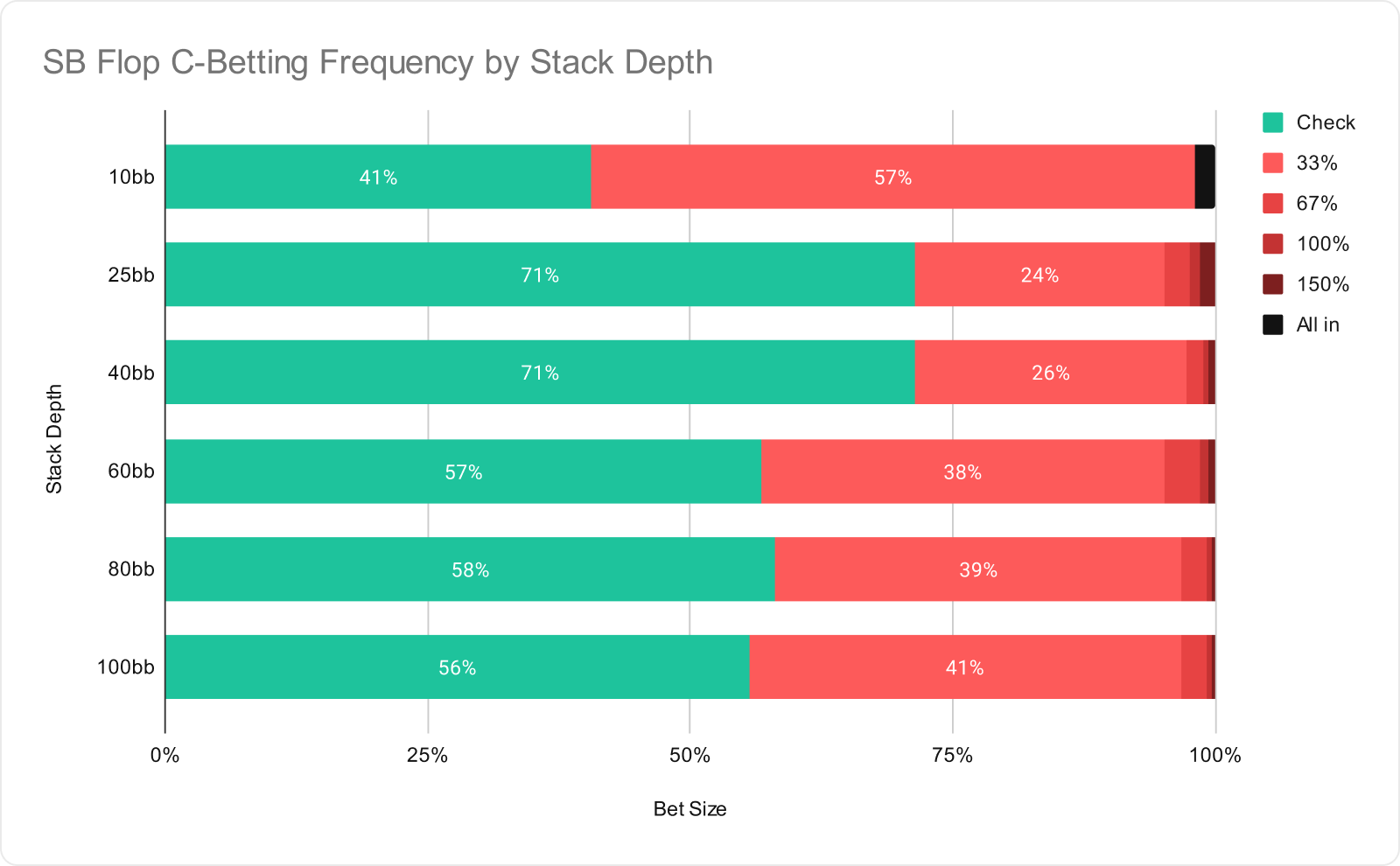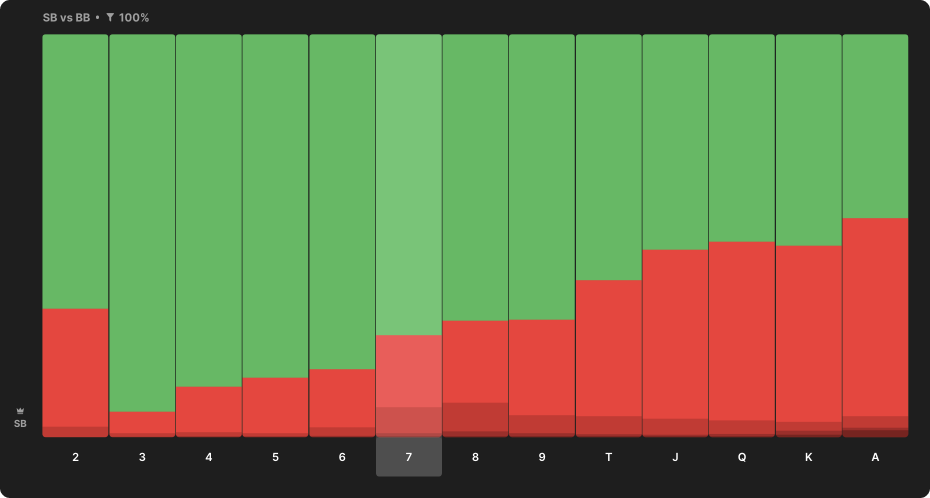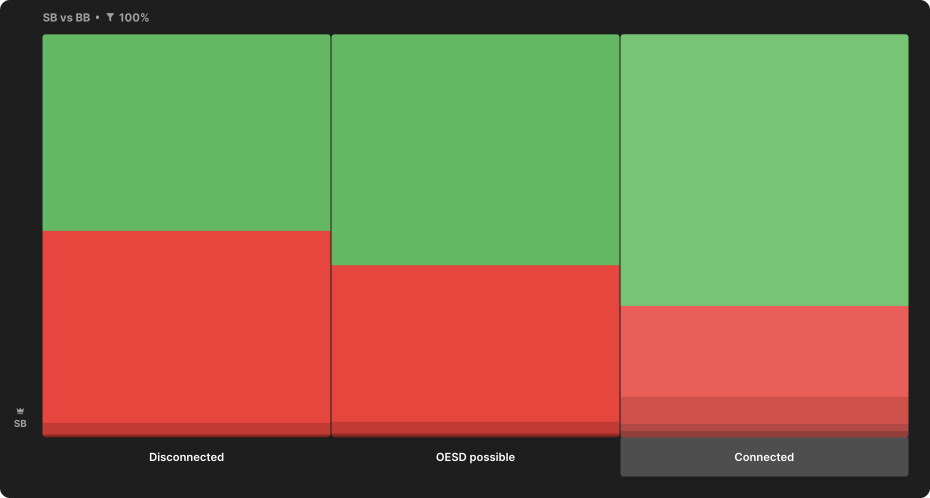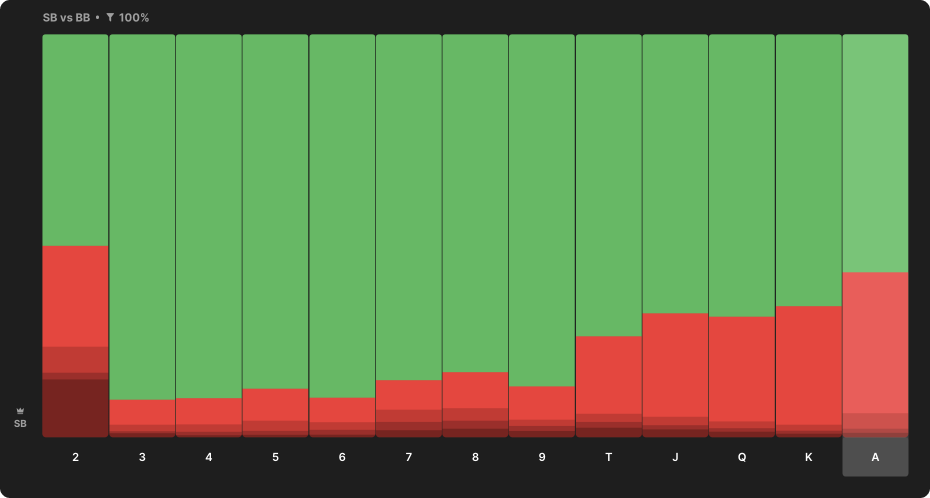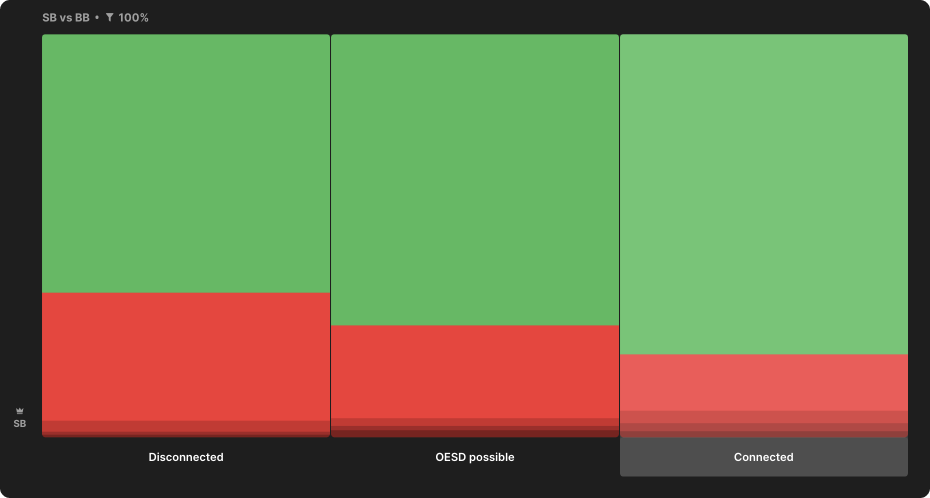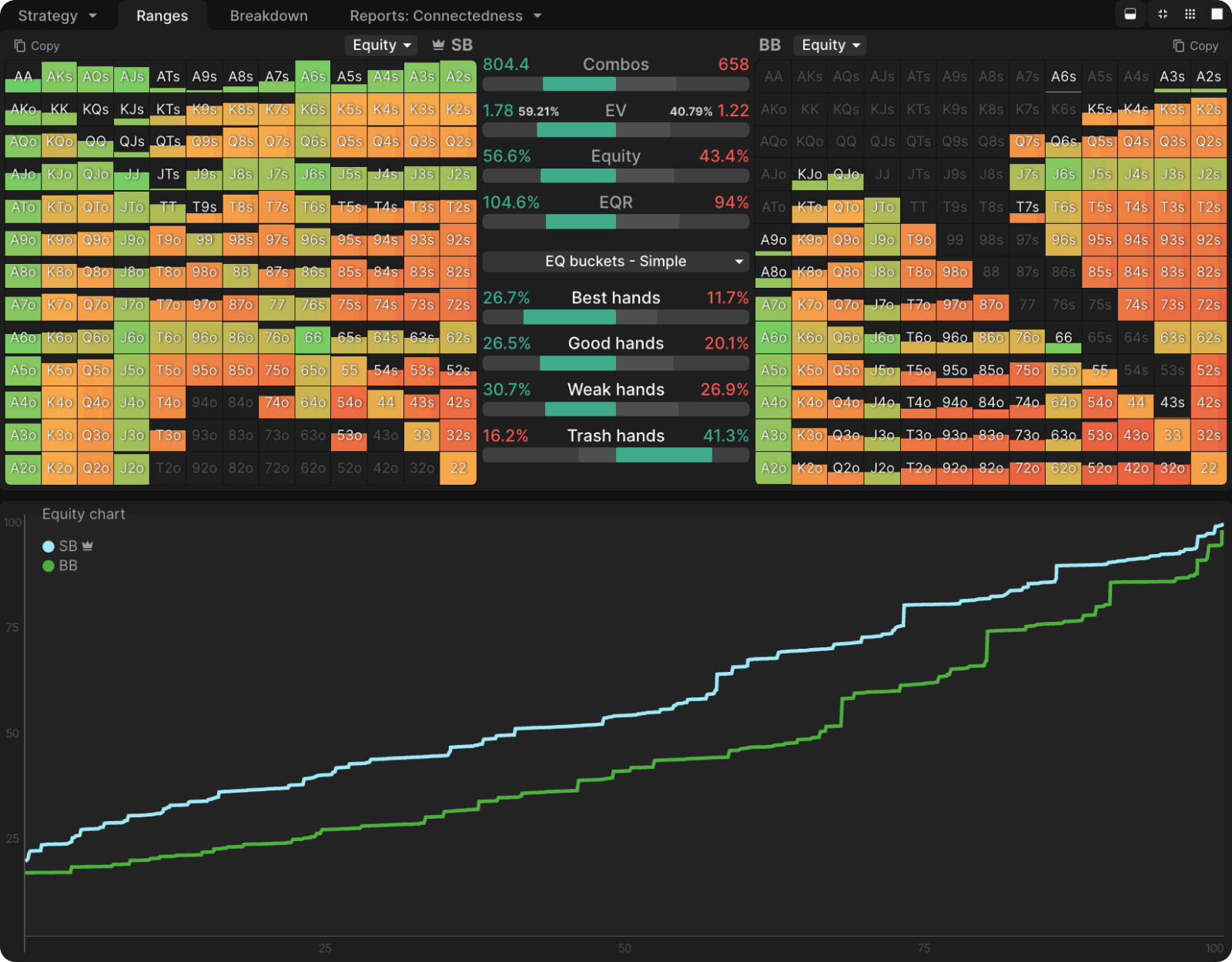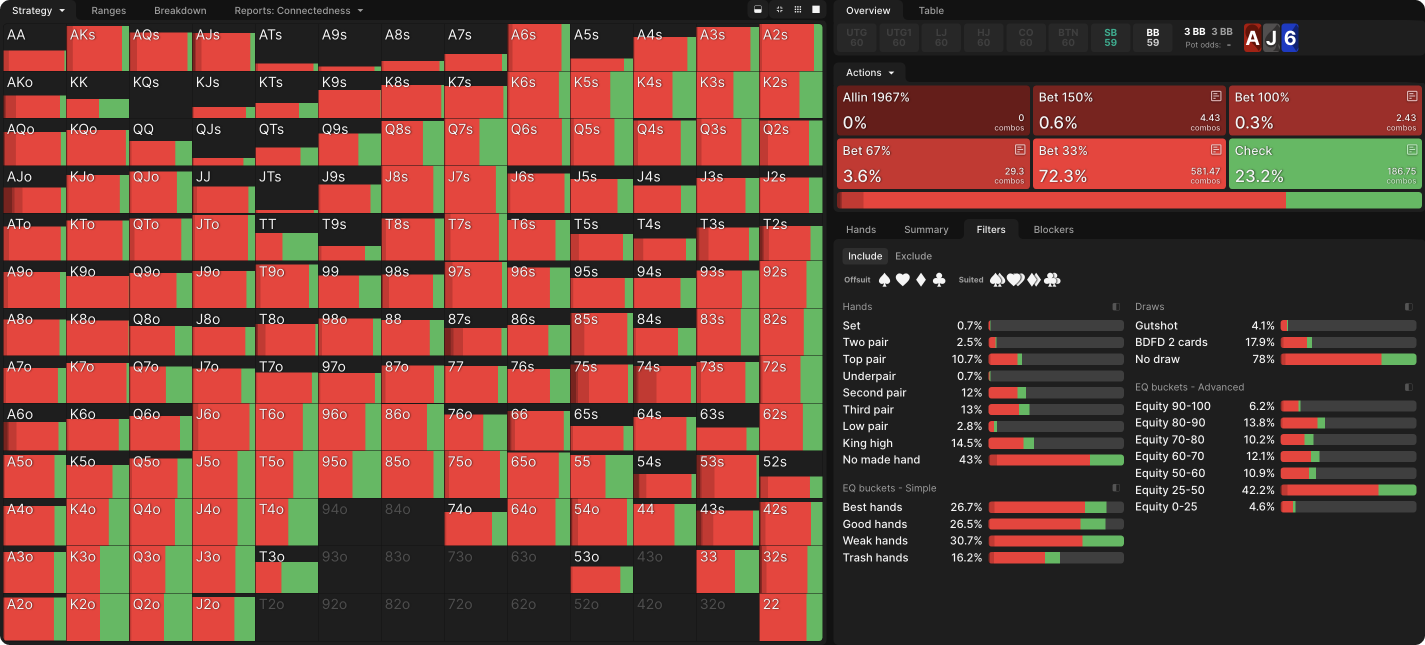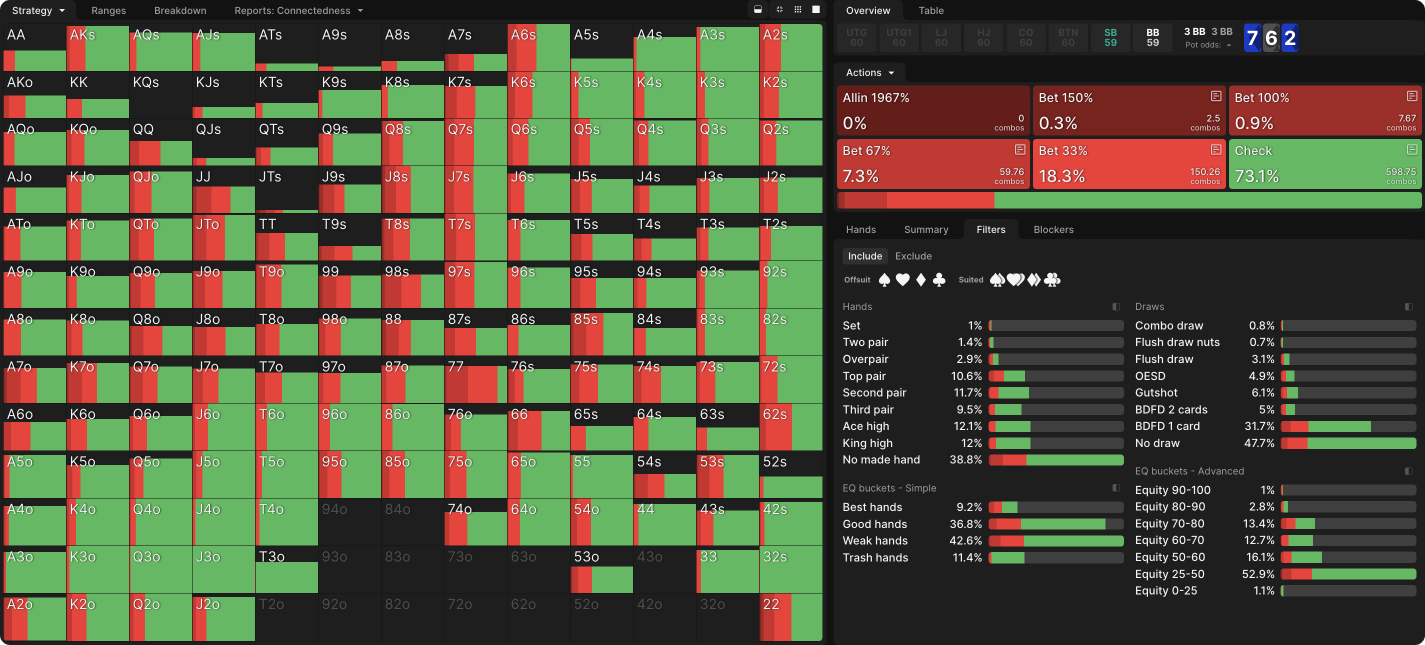Playing Limped Pots as the SB in MTTs
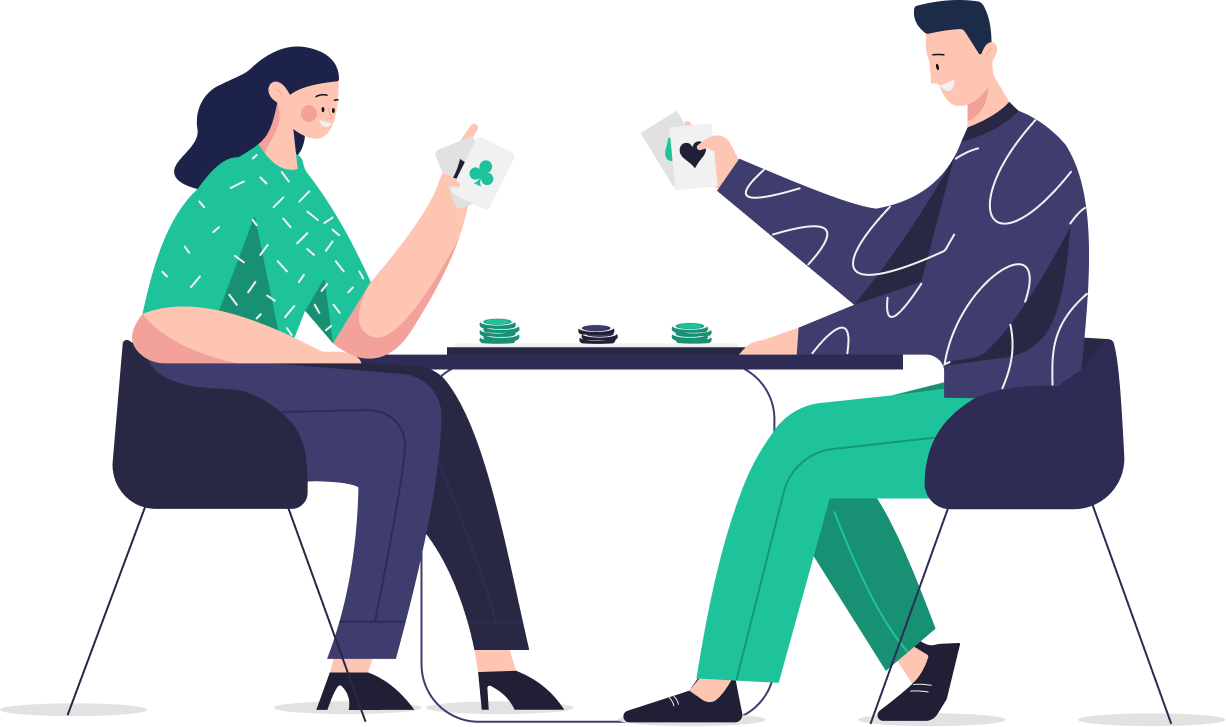
MTT confrontations between the small blind and big blind force no-limit players into uncomfortable situations, compelling them to play extremely weak hands, often with a high stack-to-pot ratio. In this unfamiliar territory, intuition is a poor guide for valuing hands or thinking about which player should drive the action and why. In this article, we will explore the flop strategy for the Small Blind in limped pots: which flops are best for betting, which hands are best for betting, and which bet size(s) to use at various stack depths.
How Large Should SB’s Flop Bets Be?
The question of bet size is easiest to answer, so we’ll start there: at all stack depths, the SB’s equilibrium strategy chooses almost exclusively between checks and small bets. These small bets facilitate a more linear betting strategy, which is important with both players holding wide and weak ranges. Virtually any hand in the SB’s range can benefit from denying equity to BB’s weakest holdings while still retaining equity against a wide calling range.
The SB chooses almost exclusively between checks and small bets at all stack depths.
The SB compensates for their positional disadvantage with a modest equity and nuts advantages on most flops. While both players in a limped pot declined to grow the pot pre-flop, the SB’s limp should be stronger than the BB’s check. This is because the SB can and should limp some strong hands as a trap, hoping to limp-reraise. The BB, whose check closes the pre-flop action, is not incentivized to check strong hands except at the very shallowest stack depths.
As the table above demonstrates, the SB’s betting frequency correlates with their equity advantage: the stronger their limping range relative to the BB’s checking range, the more frequently they bet the flop.
At the very shallowest stack depths, SB’s equity advantage is owing to the fact that the low SPR incentivizes BB to protect most of their strong hands by raising limps. This makes it more appealing for SB to limp as a trap and less likely for the BB to check strong hands, giving SB a somewhat larger equity advantage than they enjoy at the 25bb and 40bb stack depths.
With even deeper stacks, the SB once again has a lot of incentive to limp traps, as limp re-raising is more appealing for their strong hands than playing a single raised pot out of position after the flop. The BB also has a lot of incentive to raise their best hands, which risk losing much of their value with a high SPR in a limped pot. So, even though the SB has a wider limping range with deeper stacks, it is not weaker than their range at shallower stack sizes: those extra limps represent not only weak hands that fold at shallow stack sizes but also strong hands that raise at shallower stack sizes.
Which Flops Should SB Bet?
The goal is to hone your ability to predict betting frequency from flop texture, not to memorize frequencies for a specific subset of flops.
Three factors drive the SB’s flop betting frequency in limped pots:
- The extent of their equity advantage. SB starts with the stronger pre-flop range in a limped pot. The more the flop helps them relative to the BB, the more often they will bet.
- The extent of their nuts advantage. SB has more incentive to limp big cards, including big pocket pairs, than BB has to check them. SB will bet more often on flops on which a single, big pair performs well.
- The extent of their positional disadvantage. Being out of position is always bad, but it is worse on more dynamic boards. The easier it will be for BB to turn strong hands, the harder it will be for SB to deny them equity with a flop bet and so the less frequently SB will bet.
Here are some flop reports for 60bb stacks. Notice that SB bets more often when big cards flop (except for the 222 flop, where their overpairs give them a significant nuts advantage). These flops tend to magnify their equity and nuts advantages, and they are also more static, with top pair being harder to draw out on. SB also prefers betting disconnected flops, which are more static and better for the kinds of strong one pair hands SB is more likely to make.
The same patterns are on display at 25bb.
AJ6r is a good example of a disconnected high card board that is especially good for the SB. With 60bb stacks, they have nearly 57% equity and many more of the Best Hands and Good Hands.
As a result, they bet about 77% of their range, using the small bet almost exclusively.
Which Hands Should SB Bet?
With such a big range advantage, it’s hard to go wrong betting. On the AJ6r flop, literally every hand is a candidate for betting, though some are better than others.
SB’s checks come not from their worst hands but from their modest holdings, those with 25-50% equity. With such wide ranges, K-high and even Q-high are not worthless hands. On the contrary, they are mostly strong enough to check and call a small flop bet, especially when they have a backdoor flush draw to go along with their backdoor straight draw.
With both players starting with such wide ranges, the rank of your unpaired hands matters quite a bit.
Properly valuing unpaired hands like these is the trickiest part of playing limped, blind vs blind confrontations. Many players are too quick to assume they must either bluff or fold when they have no pair, but with both players starting with such wide ranges, the rank of your unpaired hands matters quite a bit.
Things get even tricker on lower and more coordinated flops, where SB must be more selective with their betting. Here’s their strategy with 60bb on 762TT.
Far more hands fall into the 25-50% equity bucket on this flop; that’s what makes it more dynamic. SB has no pure bets, but the hands they best often are either already strong (middle pair or better) or drawing to something strong (flush draws, straight draws, backdoor draws). Hands as strong as A♥ 3♥ and K♣5♣ are pure checks, with the intention of folding to even a small bet.
The problem with these hands is not that they lack equity. A♥ 3♥ flops nearly 45% equity and retains about 40% equity vs BB’s 33% pot bet. The trouble is equity realization. Ace-high will be a difficult hand to take to showdown, as BB will be able to bluff and value bet effectively on many runouts.
Even when A♥ 3♥ improves, it improves mostly to marginal hands that will still be tricky to play. Turning third pair when an open-ended straight draw comes in is nothing to celebrate. Turning an Ace is nice, but one of the three Aces will also put three diamonds on the board. Even backdooring a straight can get dicey, as it will be the low end of a four-card straight on the board and there may well be flushes to worry about as well.
Being likely ahead is a reason not to bet.
This gets at another common misunderstanding. Many players believe they should bet the flop with hands like A♥ 3♥ that are likely ahead but vulnerable to both free cards and bluffs. In fact, being likely ahead is a reason not to bet. SB is better off bluffing with weaker hands, those that benefit more from fold equity but also have more potential to improve when called. Even though A♥ 3♥ and similar hands will fold if they face a flop bet, checking them is not the same as giving up. BB checks back more than half the time at equilibrium, in which case these hands retain their value.
Common Exploits
Though we have identified certain types of hands that many humans bet more often than a solver would, these bets are not necessarily mistakes. Precisely because blind versus blind play is so tricky, it is also very possible your opponents will make big mistakes which could make these bets profitable exploits.
For example, at all stack depths, the BB’s equilibrium strategy involves a polar raising range versus the SB’s limp, with hands like 72o and T4o raising very aggressively. Many human players, however, raise a more linear range from the BB, preferring to check their worst hands and grow the pot with only “good” hands. This results in an overly weak checking range and a much larger equity advantage for the SB in a limped pot, which increases the value of many of SB’s flop bets relative to the equilibrium.
Many human players are also prone to undervaluing their own weak or unpaired hands when facing a flop bet in the BB, leading to too much folding and not enough raising. This, too, will increase the value of many of SB’s bets, turning hands that would bet rarely or never at equilibrium into profitable bets.
Later Streets
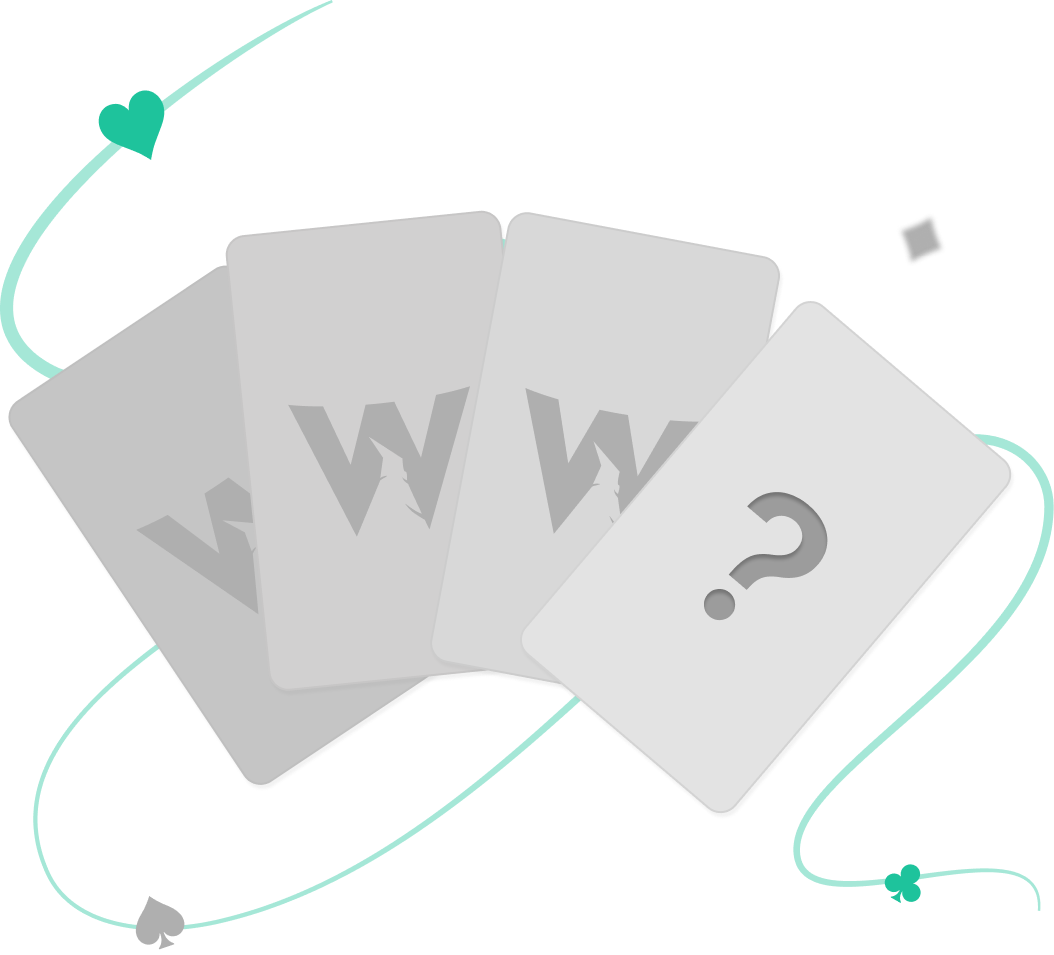
It’s hard to generalize across so many different turn and river scenarios, but it’s helpful to recognize that these limped pots are not as unfamiliar as they seem. The principles driving the flop strategy are similar to those for continuation betting from out of position, and the principles for turn and river play are similar as well.
Two of these principles are of particular importance:
- When the flop checks through, the player favored by the flop usually retains their advantage. This means on an unfavorable flop like the 762tt, the SB does not get profitable bluffs. Their worst hands are indifferent to bluffing the turn and river even if there was no action on earlier streets. Conversely, on more favorable boards like AJ6r, the SB should bluff their worst hands at some point if the BB has not bet. That means any trash hands that do not bluff the flop or turn are profitable bluffs on the river. They do not need to cause the BB to fold any “good” hands, just to push them off trash hands of their own.
- If the SB bets the flop at a high frequency, they should have a lower betting frequency and a more polar range on most turns. They only get to “cash in” their equity advantage once. The flop bet should garner a lot of folds, but when the BB does call, they will have the stronger range. Unless the turn changes that dynamic, the SB will have to be more selective going forward.
Conclusion
Fortunately, these will also be tricky spots for your opponent to play well. Your own play does not have to be perfect to outperform theirs, and indeed, their mistakes may even turn some of your own into profitable exploits.
Navigating blind versus blind confrontations requires understanding and applying the fundamentals of poker strategy: how equity is distributed between the players and across each player’s range, how much specific hands benefit from growing the pot or denying equity, etc. Relying on intuitions about hand strength and betting frequency derived from single raised pot confrontations between an in position raiser and a BB caller is as impractical as memorizing all the mixed strategies in a solver output.
Author
Andrew Brokos
Andrew Brokos has been a professional poker player, coach, and author for over 15 years. He co-hosts the Thinking Poker Podcast and is the author of the Play Optimal Poker books, among others.

